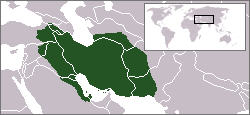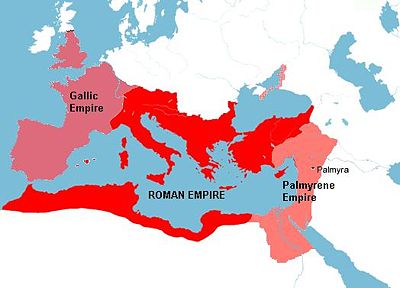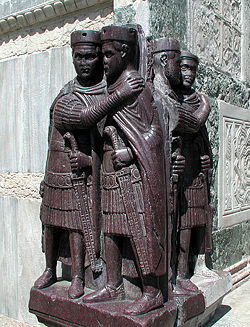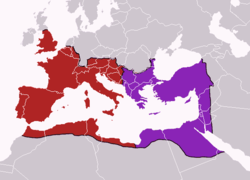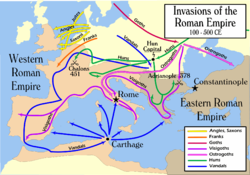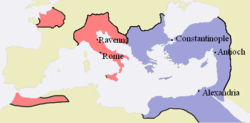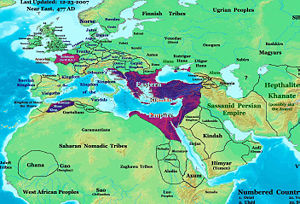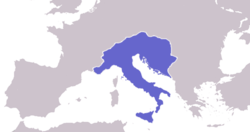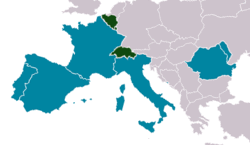Western Roman Empire
2008/9 Schools Wikipedia Selection. Related subjects: Ancient History, Classical History and Mythology; European Geography
|
|||||||||||||||||||||||||||||||||||||||||||||||||||||||||||||||||||||||
The Western Roman Empire refers to the western half of the Roman Empire, from its division by Diocletian in 285; the other half of the Roman Empire was the Eastern Roman Empire, today widely known as the Byzantine Empire.
Rome ceased to be the capital from the time of the division. In 286, the capital of the Western Roman Empire became Mediolanum (modern Milan). In 402, the capital was again moved, this time to Ravenna.
The Western Empire existed intermittently in several periods between the 3rd century and 5th century, after Diocletian's Tetrarchy and the reunifications associated with Constantine the Great and Julian the Apostate ( 324- 363). Theodosius I ( 379- 395) was the last Roman Emperor who ruled over a unified Roman empire. After his death in 395, the Roman Empire was permanently divided. The Western Roman Empire ended officially with the abdication of Romulus Augustus under pressure of Odoacer on 4 September 476, and unofficially with the death of Julius Nepos in 480.
Despite a brief period of reconquest by its counterpart, the Eastern Roman Empire, the Western Roman Empire would not rise again. As the Western Roman Empire fell, a new era began in Western European history: the Middle Ages.
Background
As the Roman Republic expanded, it reached a point at which the central government in Rome could not effectively rule the distant provinces. Communications and transportation were especially problematic, given the vast extent of the Empire. News of invasion, revolt, natural disaster, or epidemic outbreak was carried by ship or mounted postal service, often requiring much time to reach Rome, and for Rome's orders to be realized in the province of origin. For this reason, provincial governors had de facto rule in the name of the Roman republic.
Prior to the establishment of the Empire, the territories of the Roman Republic had been divided among the Second Triumvirate, composed of Octavian, Mark Antony, and Marcus Aemilius Lepidus. Antony received the provinces in the East: Achaea, Macedonia and Epirus (roughly modern Greece), Bithynia, Pontus and Asia (roughly modern Turkey), Syria, Cyprus and Cyrenaica. These lands had previously been conquered by Alexander the Great; thus, much of the aristocracy was of Greek and Macedonian origin. The whole region, especially the major cities, had been largely assimilated into Greek culture, Greek often serving as the lingua-franca.
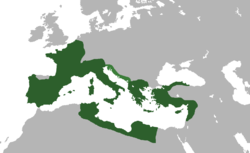
Octavian, on the other hand, obtained the Roman provinces of the West: Italia (modern Italy), Gaul (modern France), Gallia Belgica (parts of modern Belgium, the Netherlands and Luxembourg) and Hispania (modern Spain and Portugal). These lands also included Greek and Carthaginian colonies in the coastal areas, though Celtic tribes such as Gauls and Celtiberians were culturally dominant.
Lepidus received the minor province of Africa (roughly modern Tunisia). Octavian soon took Africa from Lepidus, while adding Greek-colonized Sicilia (modern Sicily) to his holdings.
Upon the defeat of Mark Antony, a victorious Octavian controlled a united Roman Empire. While the Roman Empire featured many distinct cultures, all were often said to experience gradual Romanization. While the predominantly Greek culture of the East and the predominantly Latin culture of the West functioned effectively as an integrated whole, political and military developments would ultimately realign the Empire along those cultural and linguistic lines.
Rebellions, uprisings and political consequences
Minor rebellions and uprisings were fairly common events throughout the Empire. Conquered tribes or cities would revolt, and the legions would be detached to crush the rebellion. While this process was simple in peacetime, it could be considerably more complicated in wartime, as for example in the Great Jewish Revolt .
In a full-blown military campaign, the legions, under generals such as Vespasian, were far more numerous. To ensure a commander's loyalty, a pragmatic emperor might hold some members of the general's family hostage. To this end, Nero effectively held Domitian and Quintus Petillius Cerialis, governor of Ostia, who were respectively the younger son and brother-in-law of Vespasian. The rule of Nero ended only with the revolt of the Praetorian Guard, who had been bribed in the name of Galba. The Praetorian Guard, a figurative "sword of Damocles", were often perceived as being of dubious loyalty. Following their example, the legions at the borders increasingly participated in the civil wars.
The main enemy in the West was arguably the Germanic tribes behind the rivers Rhine and Danube. Augustus had tried to conquer them but ultimately pulled back after the Teutoburg reversal.
Parthia, in the East, on the other hand, was too remote and powerful to be conquered. Any Parthian invasion was confronted and usually defeated, and the Parthians similarly repelled any Roman invasion, creating a stalemate situation.
Controlling the western border of Rome was reasonably easy, because it was relatively near, but controlling both frontiers at the same time during wartime was difficult. If the emperor was near the border in the East, chances were high that an ambitious general would rebel in the West and vice-versa, making the Empire doubly vulnerable. This wartime opportunism plagued many ruling emperors, and indeed paved the road to power for several future emperors.
Economic stagnation in the West
Rome and the Italian peninsula began to experience an economic slowdown as industries and money began to move outward. By the beginning of the 2nd century AD, the economic stagnation of Italia was seen in the provincial-born Emperors, such as Trajan and Hadrian. Economic problems increased in strength and frequency.
Crisis of the 3rd century
Starting on 18 March 235, with the assassination of the Emperor Alexander Severus, the Roman Empire sank into a 50-year civil war, known today as the Crisis of the Third Century. The rise of the bellicose Sassanid dynasty in Parthia posed a major threat to Rome in the east. Demonstrating the increased danger, Emperor Valerian was captured by Shapur I in 259. His eldest son and heir-apparent, Gallienus, succeeded and took up the fight on the eastern frontier. Gallienus' son, Saloninus, and the Praetorian Prefect Silvanus, were residing in Colonia Agrippina (modern Cologne) to solidify the loyalty of the local legions. Nevertheless, Marcus Cassianius Latinius Postumus, the local governor of the German provinces, rebelled; his assault on Colonia Agrippina resulted in the deaths of Saloninus and the prefect. In the confusion that followed, an independent state known as the Gallic Empire emerged.
Its capital was Augusta Treverorum (modern Trier), and it quickly expanded its control over the German and Gaulish provinces and over all of Hispania and Britannia. It had its own senate, and a partial list of its consuls still survives. It maintained Roman religion, language, and culture, and was far more concerned with fighting the Germanic tribes than other Romans. However, in the reign of Claudius Gothicus (268 to 270), large expanses of the Gallic Empire were restored to Roman rule.
At roughly the same time, the eastern provinces seceded as the Empire of Palmyra, or the Palmyrene Empire, under the rule of Queen Zenobia.
In 272, Emperor Aurelian finally managed to subdue Palmyra and reclaim its territory for the empire. With the East secure, he turned his attention to the West, taking the Gallic Empire a year later. Because of a secret deal between Aurelian and Gallic Emperor Tetricus I and his son Tetricus II, the Gallic army was swiftly defeated. In exchange, Aurelian spared their lives and gave the two former rebels important positions in Italy.
Tetrarchy
The external borders were mostly quiet for the remainder of the Crisis of the Third Century, although between the death of Aurelian in 275 and the accession of Diocletian ten years later, at least eight emperors or would-be emperors were killed, many assassinated by their own troops.
Under Diocletian, the political division of the Roman Empire began. In 286, through the creation of the Tetrarchy, he gave the western part to Maximian as Augustus and named Constantius Chlorus as his subordinate ( Caesar). This system effectively divided the empire into four parts and created separate capitals besides Rome as a way to avoid the civil unrest that had marked the 3rd century. In the West, the capitals were Maximian's Mediolanum (now Milan) and Constantius' Trier. On 1 May 305, the two senior Augusti stepped down and were replaced by their respective Caesars.
Constantine
The system of the Tetrarchy quickly ran aground when the Western Empire's Constantius died unexpectedly in 306, and his son Constantine was proclaimed Augustus of the West by the legions in Britain. A crisis followed as several claimants attempted to rule the Western half. In 308, the Augustus of the East, Galerius, arranged a conference at Carnuntum which revived the Tetrarchy by dividing the West between Constantine and a newcomer named Licinius. Constantine was far more interested in reconquering the whole empire. Through a series of battles in the East and the West, Licinius and Constantine stabilized their respective parts of the Roman Empire by 314, and they now competed for sole control of a reunified state. Constantine emerged victorious in 324 after the surrender and murder of Licinius following the Battle of Chrysopolis.
The Tetrarchy was dead, but the idea of dividing the Roman Empire between two emperors had been validated. Very strong emperors would reunite it under their single rule, but with their death the Roman Empire would be divided again and again between the East and the West.
Second division
The Roman Empire was under the rule of a single Emperor, but with the death of Constantine in 337, civil war erupted among his three sons, dividing the empire into three parts. The West was reunified in 340, and a complete reunification of the whole empire occurred in 353, with Constantius II.
Constantius II focused most of his power in the East, and is often regarded as the first emperor of the Byzantine Empire. Under his rule, the city of Byzantium, only recently refounded as Constantinople, was fully developed as a capital.
In 361, Constantius II became ill and died, and Constantius Chlorus' grandson Julian, who had served as Constantius II's Caesar, took power. Julian was killed carrying on Constantius II's war against Persia in 363 and was replaced by Jovian who ruled only until 364.
Final division
Following the death of Jovian, Valentinian I emerged as emperor in 364. He immediately divided the empire once again, giving the eastern half to his brother Valens. Stability was not achieved for long in either half as the conflicts with outside forces intensified. In 376 the Visigoths, fleeing before the Huns, were allowed to cross the river Donau and settle into the Balkans by the Eastern government. Maltreatment on the side of the Romans then caused them to rebel, and in 378 they inflicted a crippling defeat on the Eastern Roman field army in the Battle of Adrianople, in which Valens also died. After roaming the Balkans for a while, the Visigoths settled in Epirus, where they remained a hostile foreign element within the empire that posed a constant threat to both halves until they finally moved into Italy shortly after 400.
More than in the East, there was also opposition to the Christianizing policy of the emperors in the western half of the empire. In 379 Valentinian I's son and successor Gratian declined to wear the mantle of pontifex maximus, and in 382 he rescinded the rights of pagan priests and removed the pagan altar from the Roman Curia, a decision which caused dissatisfaction among the traditionally pagan aristocracy of Rome.
The political situation was unstable. In 383, a powerful and popular general named Magnus Maximus seized power in the west and forced Gratian's son Valentinian II to flee to the east for aid; the Eastern Emperor Theodosius I promptly restored him to power. He also caused a ban on the native paganism to be implemented in the west in 399, enforcing Christianity. In 392 the Frankish and pagan magister militum Arbogast assassinated Valentinian II and proclaimed an obscure senator named Eugenius as emperor. The rebellion was overcome in 394 by Theodosius I, who then shortly ruled a united Empire until his death in 395. This was the last instance in which a single ruler ruled both parts of the Roman Empire; his sons, Honorius and Arcadius, were given the western and eastern half, respectively. Still minors, they were placed under the tutelage of the semi-barbarian magister militum Flavius Stilicho.
Stilicho ably defended Italy against the invading Goths, but he became a victim of court intrigues in Ravenna (where the imperial court resided since 402) and was executed for high treason in 408. In the preceding year Vandals, Alans and Suevi had invaded Gaul in massive numbers, and while the East began a slow recovery and consolidation, the West began to collapse entirely.
Economic factors
While the West was experiencing an economic decline throughout the late empire, the East was not so destitute, as Emperors like Constantine the Great and Constantius II had invested heavily in the eastern economy. The economic decline of the West contributed to its eventual collapse. While being much less urbanized and less densely populated, it stretched over a larger area and had a longer boundary to defend than the Eastern empire. The Byzantine Empire could afford large numbers of professional soldiers and augment them with mercenaries while the Western Roman Empire couldn't afford this to the same extent. Even in the case of a major defeat the East could, certainly not without difficulties, buy its enemies off with a ransom. The Western empire's resources were much more limited, and the lack of available manpower forced the government to rely ever more on confederate barbarian troops operating under their own commanders.
As the central power weakened, the State lost control of its borders and provinces, as well as control over the Mediterranean Sea. Roman Emperors tried to maintain control of the sea, but once the Vandals conquered North Africa, imperial authorities had to cover too much ground with too few resources. In many places the Roman institutions collapsed along with the economic stability. In some regions, such as Gaul and Italy, the settlement of barbarians on former Roman lands seems to have caused relatively little disruption, whereas elsewhere, notably in certain parts of North Africa, the Roman landowners were expelled and their lands confiscated.
Sack of Rome and fall of the Western Roman Empire
With the death of Stilicho in 408, Honorius was left in charge, and although he ruled until his death in 423, his reign was filled with usurpations and invasions. In 410, Rome was sacked by Alaric's forces. This event made a great impression on contemporaries, as this was the first time since the Gallic invasions of the 4th century BC that the city had fallen to a foreign enemy. Under Alaric's successors the Goths then settled in Gaul (412-418), from where they operated as Roman allies against the Vandals, Alans and Suevi in Spain, and against the usurpator Jovinus (413). Meanwhile another usurpator, Constantine (406-411), had stripped Roman Britain of its defenses when he crossed over to Gaul in 407, leaving the Romanized population subject to invasions, first by the Picts and then by the Saxons and Angli, who began to settle permanently on the island from about 440 onwards.
Honorius' death in 423 was followed by turmoil until the Eastern Roman government with the force of arms installed Valentinian III as Western Emperor in Ravenna, with Galla Placidia acting as regent during her son's minority. After a violent struggle with several rivals, and against Placidia's wish, Aetius rose to the rank of magister militum. Aetius was able to stabilize the empire's military situation somewhat, relying heavily on his Hunnic allies. With their help he defeated the Burgundians, who had occupied part of southern Gaul after 407, and settled them in Savoy as Roman allies (433). Later that century, as Roman power faded away, the Burgundians extended their rule to the Rhone valley.
Meanwhile, pressure from the Visigoths and a rebellion by the governor of Africa, Bonifacius, had induced the Vandals under their king Gaiseric to cross over from Spain in 429. They temporarily halted in Numidia (435) before moving eastward and capturing Carthage, from where they established an independent state with a powerful navy ( 439). The Vandal fleet from then on formed a constant danger to Roman seafare and the coasts and islands of the Western and Central Mediterranean.
In 444 the Huns, who had been employed as Roman allies by Aetius, were united under their ambitious king Attila. When Attila turned against his former ally the Huns became a formidable threat to the empire. Attila asked for the hand of the emperor's sister Honoria with half the Western Empire's territory as his dowry. When this was refused he invaded Gaul and was only stopped with great effort by a combined Roman-Germanic force led by Aetius in the Battle of Chalons (451). The next year Attila invaded Italy and proceeded to march upon Rome, but an outbreak of disease in his army, pope Leo's plea for peace, the superstitious fear (as reported by Priscus) of the fate of Alaric (who died shortly after sacking Rome in 410), and reports of a campaign of Marcianus directed at his headquarters in Pannonia induced him to halt this campaign. Attila suddenly died a year later (453).
Aetius was slain by Valentinian, who had grown jealous of his power, in 454, and Valentinian was then himself murdered by the dead general's supporters a year later. With the end of the Theodosian dynasty, a new period of dynastic struggle ensued. The Vandals took advantage of the unrest and sailed up to Rome, which they plundered in 455.
The instability caused by usurpers throughout the Western Empire helped these tribes in their conquests, and by the 450s the Germanic tribes had become usurpers themselves. During the next twenty years, several Western emperors were installed by Constantinople, but their authority only reached as far as the barbarian commanders of the Roman troops ( Ricimer (456-472), Gundobad (473-475)) allowed it to. In 475, Orestes, a former secretary of Attila, drove Emperor Julius Nepos out of Ravenna and proclaimed his own son Romulus Augustus as emperor.
In 476, Orestes refused to grant Odoacer and the Heruli federated status, prompting him to send the imperial insignia to Constantinople, installing himself as king over Italy. Although isolated pockets of Roman rule continued even after 476, the city of Rome itself was under the rule of the barbarians, and the control of Rome over the West had effectively ended. There is considered to be three rump states that continued under Roman rule in some form or another after 476, Julius Nepos controlled Dalmatia until his murder in 480, Syagrius was declared King of the Romans and ruled the Domain of Soissons until his murder in 487. Lastly, a Roman-Moor Kingdom survived in north Africa, this last bastion of Roman rule in the West resisted Vandal conquest and was re-united with the Eastern Roman Empire c.533 when Belisarius reconquered North Africa.
Last Emperor
Historical convention has determined that the Western Roman Empire ended on 4 September 476, when Odoacer deposed Romulus Augustulus. However, the issue is not clear-cut and some consider Julius Nepos, who died in 480 AD, to be the last Roman Emperor.
Julius Nepos still claimed to be Emperor of the West, ruling the rump state in Dalmatia. He was recognized as such by Byzantine Emperor Zeno and by Syagrius, who had managed to preserve Roman sovereignty in a exclave in northern Gaul, known today as the Domain of Soissons. Odoacer proclaimed himself ruler of Italy and began to negotiate with Zeno. Zeno eventually granted Odoacer patrician status as recognition of his authority and accepted him as his own viceroy of Italy. Zeno however insisted that Odoacer paid homage to Julius Nepos as the Emperor of the Western Empire. Odoacer accepted this condition and even issued coins in the name of Julius Nepos throughout Italy. This however was mainly an empty political gesture as Odoacer never returned any real power or territories to Julius Nepos. The murder of Julius Nepos in 480 prompted Odoacer to invade Dalmatia, annexing it to his Kingdom of Italy and ending the opportunity of any claims by others to the Western throne.
Theodoric
The last hope for a reunited Empire came in 493, as Odoacer was replaced by Theodoric the Great, king of the Ostrogoths. Theodoric had been recruited by Zeno to deal with a dangerous Odoacer. While in principle Theodoric was a subordinate, a viceroy of the emperor of the East, actually he was an equal.
Following Theodoric's death in 526, the West no longer resembled the East. The West was now fully controlled by invading outside tribes, while the East had retreated and Hellenized. While the East would make some attempts to recapture the West, the Roman Empire was never the same again.
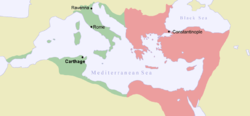
Byzantine reconquest
Throughout the Middle Ages, the eastern, so-called "Byzantine Empire" laid claims on areas of the West which had been occupied by several tribes. In the 6th century, the Byzantine Empire managed to reconquer large areas of the former Western Roman Empire. The most successful were the campaigns of the Byzantine generals Belisarius and Narses on behalf of Emperor Justinian I from 533 to 554. The Vandal-occupied former Roman territory in North Africa was regained, particularly the territory centred around the city of Carthage. The campaign eventually moved into Italy and reconquered it completely. Minor territories were taken as far west as the southern coast of the Iberian Peninsula.
It appeared at the time that perhaps Rome could be reconstituted. However, the tribal influence had caused far too much damage to these former Roman provinces, both economically and culturally. Not only were they extremely costly to maintain, the invasion and propagation of the Germanic tribes throughout these territories meant that much of the Roman culture and identity that had held the empire together had been destroyed or severely damaged.
Although some eastern emperors occasionally attempted to reconquer some parts of the West, none were as successful as Justinian. The division between the two areas grew, resulting in a growing rivalry. While the Eastern Roman Empire continued after Justinian, the eastern emperors focused mainly on defending its traditional territory. The East no longer had the necessary military strength, spelling the end of any hope for reunification.
Legacy
As the Western Roman Empire crumbled, the new Germanic rulers who conquered the provinces nonetheless upheld many Roman laws and traditions. Many of the invading Germanic tribes were already Christianised, though most were followers of Arianism. They quickly converted to Catholicism, gaining more loyalty from the local Roman populations, as well as the recognition and support of the powerful Roman Catholic Church. Although they initially continued to recognise indigenous tribal laws, they were more influenced by Roman Law and gradually incorporated it as well.
Roman Law, particularly the Corpus Juris Civilis collected by order of Justinian I, is the ancient basis on which the modern Civil law stands. In contrast, Common law is based on the Germanic Anglo-Saxon law.
Latin as a language never really disappeared. It combined with neighboring Germanic and Celtic languages, giving rise to many modern Romance languages such as Italian, French, Spanish, Portuguese, Romanian and Romansh. Latin also influenced Germanic languages such as English, German, and Dutch. It survives in its "purer" form as the language of the Roman Catholic Church (the Mass was spoken exclusively in Latin until 1969) and was used as a lingua franca between many nations. It remained the language of medicine, law, diplomacy (most treaties were written in Latin), of intellectuals and scholarship.
The Latin alphabet was expanded with the letters J, K, W and Z and is the most widely used alphabetic writing system in the world today. Roman numerals continue to be used but were mostly replaced by Arabic numerals.
The ideal of the Roman Empire as a mighty Christian Empire with a single ruler continued to seduce many powerful rulers. Charlemagne, King of the Franks and Lombards, was even crowned as Roman Emperor by Pope Leo III in 800. Emperors of the Holy Roman Empire like Otto I, Frederick I Barbarossa, Frederick II, and Charles V, French King Louis XIV, as well as French Emperor Napoleon I, among others, tried to a certain extent to resurrect it, but none of their attempts were ultimately successful.
A very visible legacy of the Western Roman Empire is the Roman Catholic Church. The Church slowly began to replace Roman institutions in the West, even helping to negotiate the safety of Rome during the late 5th century. As Rome was invaded by Germanic tribes, many assimilated, and by the middle of the medieval period (c.9th and 10th centuries) the central, western and northern parts of Europe had been largely converted to the Roman Catholic Church and acknowledged the Pope as the Vicar of Christ.
List of Western Roman emperors
Gallic Emperors (259 to 273)
- Postumus: 259 to 268
- Laelianus: 268 Usurper
- Marcus Aurelius Marius: 268
- Victorinus: 268 to 271
- Domitianus: 271 Usurper
- Tetricus I: 271 to 273
- Tetricus II: 271 to 273 Son and co-emperor of Tetricus I
Tetrarchy (293 to 313)
Augusti are shown with their Caesares and regents further indented
- Maximian: 293 to 305
- Constantius Chlorus: 293 to 305
- Constantius Chlorus: 305 to 306
- Flavius Valerius Severus: 305 to 306
- Flavius Valerius Severus: 306 to 307
- Constantine I: 306 to 313
- Maxentius/ Maximian: 307 to 308
- Licinius: 308 to 313
- Maxentius: 308 to 312 Usurper
- Domitius Alexander: 308 to 309 African usurper
Constantinian dynasty (313 to 363)
- Constantine I: 313 to 337 Sole emperor of the whole Roman Empire 324 to 337
- Constantine II: 337 to 340 Emperor of Gaul, Britannia, and Hispania
- Constans I: 337 to 350 Initially emperor of Italy and Africa; emperor of the west 340 to 350
- Magnentius: 350 to 353 Usurper
- Constantius II: 353 to 361 Sole emperor
- Julian: 355 to 361
- Julian: 361 to 363
Non-dynastic (363 to 364)
- Jovian: 363 to 364
Valentinian dynasty (364 to 392)
- Valentinian I: 364 to 375
- Gratian: 367 to 375
- Gratian: 375 to 383
- Valentinian II: 375 to 383
- Magnus Maximus: 383 to 388 Usurper
- Valentinian II: 383 to 392
Non-dynastic (392 to 394)
- Eugenius: 392 to 394
Theodosian dynasty (394 to 455)
- Theodosius I: 394 to 395 Sole emperor
- Honorius: 395 to 423
- Flavius Stilicho: 395 to 408 Power behind the throne
- Constantius III: 421
- Constantine III: 407 to 411 Usurper
- Priscus Attalus: 409 to 410/414 to 415 Usurper
- Jovinus: 411 to 412 Usurper
- Valentinian III: 423 to 455
- Galla Placidia: 423 to 433 Regent
- Aëtius: 433 to 454 Regent
- Joannes: 423 to 425 Usurper
Non-dynastic (455 to 480)
- Petronius Maximus: 455
- Avitus: 455 to 456
- Ricimer: 456 to 472 Power behind the throne
- Majorian: 457 to 461
- Libius Severus: 461 to 465
- Anthemius: 467 to 472
- Olybrius: 472
- Glycerius: 473 to 474
- Julius Nepos: 474 to 480 In exile 475 to 480
- Romulus Augustus: 475 to 476
- Flavius Orestes: 475 to 476 Power behind the throne
Flavius Orestes was killed by revolting Germanic mercenaries. Their chieftain, Odoacer, assumed control of Italy as a de jure representative of Julius Nepos and Eastern Roman Emperor Zeno.

